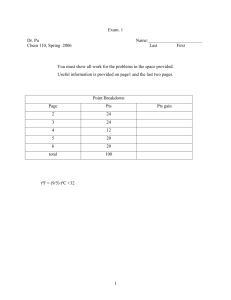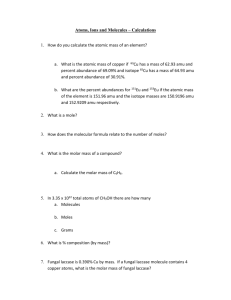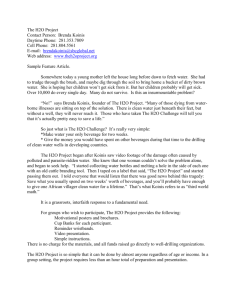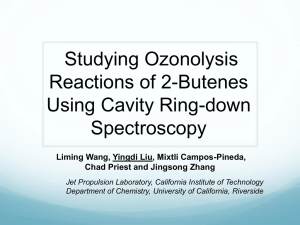1. Read each chapter. 2. Solve the following problems – get in the
advertisement
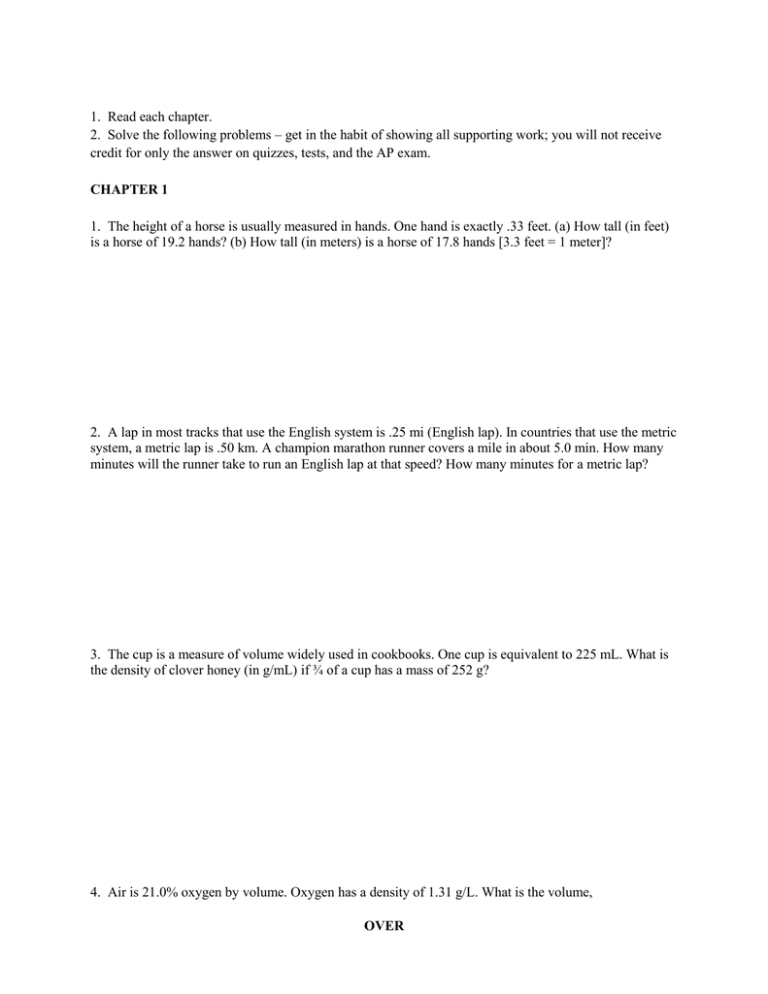
1. Read each chapter. 2. Solve the following problems – get in the habit of showing all supporting work; you will not receive credit for only the answer on quizzes, tests, and the AP exam. CHAPTER 1 1. The height of a horse is usually measured in hands. One hand is exactly .33 feet. (a) How tall (in feet) is a horse of 19.2 hands? (b) How tall (in meters) is a horse of 17.8 hands [3.3 feet = 1 meter]? 2. A lap in most tracks that use the English system is .25 mi (English lap). In countries that use the metric system, a metric lap is .50 km. A champion marathon runner covers a mile in about 5.0 min. How many minutes will the runner take to run an English lap at that speed? How many minutes for a metric lap? 3. The cup is a measure of volume widely used in cookbooks. One cup is equivalent to 225 mL. What is the density of clover honey (in g/mL) if ¾ of a cup has a mass of 252 g? 4. Air is 21.0% oxygen by volume. Oxygen has a density of 1.31 g/L. What is the volume, OVER in L, of 55.0 kg of oxygen? 5. A children’s pain relief medicine contains 80.0 mg of acetaminophen per 0.500 teaspoon. The dosage recommended for a child who weighs between 24.0 and 35.0 lbs is 1.50 teaspoons. What is the range of acetaminophen dosages, expressed in mg acetaminophen per kg body weight, for children who weigh between 24.0 and 35.0 lbs? 6. The density of an irregularly shaped object was determined as follows. The mass of the object was found to be 28.90g. A graduated cylinder was partially filled with water; the reading of the level of water was 6.40 cm3. The object was dropped into the cylinder and the level of the water rose to 9.80 cm3. What is the density of the object? 7. Apothecaries (druggists) use the following set of measures in the English system: 20 grains ap = 1 scruple (exact) 3 scruples = 1 dram ap (exact) 8 dram ap = 1 oz ap (exact) 1 dram ap = 3.888g (a) An aspirin tablet contains 5.00 x 102 mg of active ingredient. How many grains ap of active ingredient does it contain? How many scruples? (b) What is the mass of one scruple in grams? 8. A material will float on the surface of a liquid if the material has a density less than that of the liquid. Given that the density of water is approximately 1.0 g/mL, will a block of material having a volume of 1.2 x 104 in3 and a mass of 350 lb float or sink when it is placed in a reservoir of water? OVER CHAPTER 2 1. How would you go about finding the number of chalk molecules it takes to write your name on the board? Provide an explanation of all you would need to do and a sample calculation. 2. What is the distinction between atomic number and mass number? What is the distinction between mass number and atomic mass? 3. Symbol # of protons # of neutrons 33 # of electrons Net charge 30 128 Te2- 52 16 16 0 78 117 4+ 204 Tl+ 81 4. Write the formulas for the following molecules: (a) disulfur trioxide (b) carbon tetraiodide (c) dichlorine heptoxide (d) nitrogen monoxide (e) silicon dioxide (f) tetraphosphorus decasulfide (g) sulfur hexafluoride (h) arsenic pentoxide (i) sulfur difluoride (j) dinitrogen tetrafluoride (k) iodine trichloride (l) diphosphorus pentasulfide 5. Write the names of the following molecules: (a) ICl3 (b) N2O5 (c) PH3 (d) CBr4 (e) SO3 (f) CO (g) SiC (h) XeF6 (i) P4O10 (j) C2H2 6. Write the names of the following ionic compounds: OVER (a) K2Cr2O7 (b) Cu3(PO4)2 (c) Ba(C2H3O2)2 (d) AlN (e) Co(NO3)2 (f) ScCl3 (g) Sr(OH)2 (h) KMnO4 (i) Rb2S (j) Na2CO3 (k) HCl (aq) (l) HClO3 (m) Fe2(SO3)3 (n) Ba(NO2)2 (o) KIO3 (p) CuI (q) Na3AsO4 (r) NaOCl (s) KHSO3 (t) SnO2 7. Write the formulas for the following ionic compounds: (a) ammonium sulfide (b) sodium nitrite (c) chromium (III) sulfite (d) potassium chlorate (e) iron (III) perbromate (f) silver chloride (g) magnesium dihydrogen sulfate (h) calcium oxalate (i) ammonium thiocyanate (j) lead (IV) phosphate (k) cobalt (II) dichromate (l) manganese (VII) carbonate (m) aluminum hydrogen sulfate (n) strontium permanganate (o) bismuth (V) iodite (p) barium phosphide CHAPTER 3 1. Chlorine exists mainly as two isotopes, 37Cl and 35Cl. Which is more abundant? How do you know? 2. Assume the element Uus is synthesized and that it has the following stable isotopes: 284 Uus (283.4 amu) Uus (284.7 amu) 288 Uus (287.8 amu) 285 34.60% 21.20% 44.20% Determine the value of the average atomic mass for Uus that should be listed on the periodic table. 3. An element is a mixture of two isotopes. One isotope of the element has an atomic mass of 34.96885 amu and has a relative abundance of 75.53%. The other isotope has an atomic mass of 36.96590 amu. Calculate the average atomic mass of the element. 4. A diamond contains 5.00 x 1021 atoms of carbon. How many moles of carbon and how many grams of carbon are in this diamond? 5. Calculate the molar mass of each of the following substances: OVER a. P4O6 b. Ca3(PO4)2 c. (NH4)2Cr2O7 6. The molecular formula of acetylsalicyclic acid (aspirin) is C9H8O4. a. Calculate the molar mass of aspirin. b. A typical aspirin tablet contains 500. mg of aspirin. How many moles of C9H8O4 and how many molecules of C9H8O4 are in a 500. mg tablet? 7. Calculate the percent composition of methyl acrylate, C4H6O2, from which Plexiglas is made. 8. Fungal laccase, a blue protein found in wood-rotting fungi, is 0.390% Cu by mass. If a fungal laccase molecule contains 4 copper atoms, what is the molar mass of fungal laccase? 9. The compound adrenaline contains 56.79% C, 6.56% H, 28.37% O, and 8.28% N by mass. What is the empirical formula for adrenaline? 10. Adipic acid is an organic compound composed of 49.31% C, 43.79% O, and the rest hydrogen. If the molar mass of adipic acid is 146.1 g/mol, what are the empirical and molecular formulas of adipic acid? 11. Balance the following equations: OVER a. ____ Ca(OH)2 (aq) + ____ H3PO4 (aq) → ____ H2O (l) + ____ Ca3(PO4)2 (s) b. ____ AgNO3 (aq) + ____ H2SO4 (aq) → ____ Ag2SO4 (s) + ____ HNO3 (aq) c. ____ Pb(NO3)2 (aq) + ____ H3AsO4 (aq) → ____ PbHAsO4 (s) + ____ HNO3 (aq) 12. When a mixture of silver metal and sulfur is heated, silver sulfide is formed: 16 Ag (s) + S8 (s) → 8 Ag2S (s) (a) What mass of Ag2S is produced from a mixture of 2.00g Ag and 2.00g S8? (b) What mass of which reactant is left unreacted? 13. Acetaldehyde, CH3CHO, and oxygen react to produce acetic acid, HC2H3O2, as described in the following reaction: 2 CH3CHO (l) + O2 (g) → 2 HC2H3O2 (l) If 200.0g CH3CHO and 100.0g O2 are used in this reaction, determine: a. the mass of acetic acid produced b. the identity of the limiting reactant c. the identity of the reactant in excess d. the mass of excess reactant that remains after the reaction is complete e. If the actual yield is 267.9 g, determine the percent yield for this reaction. CHAPTER 4 & MISCELLANEOUS OVER The following questions / problems cover topics from your summer reading or from the end of last year’s general chemistry class. 1. Name the following acids: (a) HNO2 (b) HClO (c) H2SO3 (d) HCN (e) HI (f) HC2H3O2 2. Write the formula for each of the following acids: (a) phosphoric acid (b) hydrosulfuric acid (c) perchloric acid (d) bromic acid (e) oxalic acid (f) carbonic acid 3. Answer the following questions about BeC2O4 and its hydrate. a. Calculate the mass percent of carbon in the hydrated form of the solid that has the formula BeC2O4 ∙ 3 H2O b. When heated to 220.0C, BeC2O4 ∙ 3 H2O (s) dehydrates completely as represented below. BeC2O4 ∙ 3 H2O (s) → BeC2O4 (s) + 3 H2O (g) If 3.21 g of BeC2O4 ∙ 3 H2O (s) is heated, calculate (i) the mass of BeC2O4 (s) formed, and (ii) the volume of H2O released at 220.0C and 735 mm Hg 4. Calculate the molarity of a solution containing 5.00g of NH4Cl in 500.0 mL of solution. 5. How many grams of NaOH are contained in 250.0 mL of a 0.400 M sodium hydroxide solution? 6. Describe how you would prepare 2.00 L of 0.100 M K2CrO4 from a 1.75 M K2CrO4 stock solution. OVER 7. When the following solutions are mixed together, what precipitate (if any) will form? a. FeSO4 (aq) and KCl (aq) b. Al(NO3)3 (aq) and Ba(OH)2 (aq) c. CaCl2 (aq) and Na2SO4 (aq) 8. Re-write and balance each of the following reactions, then write the net ionic equation: a. AgNO3 (aq) + BaCl2 (aq) b. FeSO4 (aq) + K2S (aq) 9. A lake may be polluted with Pb2+ ions. What precipitation reaction might you use to test for the presence of Pb2+ ? 10. Write a net ionic equation for each reaction, if any, that occurs when aqueous solutions of the following are mixed: a. cobalt (III) chloride and sodium hydroxide b. silver nitrate and ammonium carbonate c. copper (II) sulfate and mercury (II) chloride d. strontium nitrate and potassium iodide OVER
